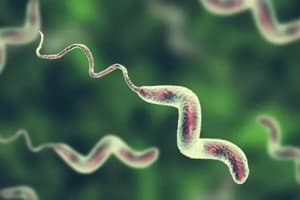Podcast
Questions and Answers
What is the optimal temperature for incubating modified Skirrow's medium to recover Campylobacter spp. from stool specimens?
What is the optimal temperature for incubating modified Skirrow's medium to recover Campylobacter spp. from stool specimens?
- 37°C
- 45°C
- 42°C (correct)
- 50°C
What is the characteristic shape of Helicobacter spp.?
What is the characteristic shape of Helicobacter spp.?
- Straight rods
- Spiral rods
- Branched rods
- Curved rods (correct)
Which of the following is a characteristic of Campylobacter spp. colonies?
Which of the following is a characteristic of Campylobacter spp. colonies?
- Colorless and dry
- Gray to pinkish or yellowish gray and slightly mucoid (correct)
- Red and shiny
- Black and rough
What is the purpose of using selective media in culturing Campylobacter spp. from stool?
What is the purpose of using selective media in culturing Campylobacter spp. from stool?
What is the typical duration of incubation required for the growth of Campylobacter spp. in blood culture media?
What is the typical duration of incubation required for the growth of Campylobacter spp. in blood culture media?
What is the characteristic motility of Campylobacter spp. in a wet preparation?
What is the characteristic motility of Campylobacter spp. in a wet preparation?
What percentage of oxygen is suitable for the growth of Campylobacter spp.?
What percentage of oxygen is suitable for the growth of Campylobacter spp.?
Which of the following animals is NOT a common inhabitant of Campylobacter spp.?
Which of the following animals is NOT a common inhabitant of Campylobacter spp.?
What is the most common syndrome associated with Campylobacter spp. infection in humans?
What is the most common syndrome associated with Campylobacter spp. infection in humans?
What is the purpose of using Cary-Blair transport medium for stool specimens?
What is the purpose of using Cary-Blair transport medium for stool specimens?
What is the characteristic microscopic morphology of Campylobacter spp.?
What is the characteristic microscopic morphology of Campylobacter spp.?
What is the recommended storage temperature for specimens received in transport medium?
What is the recommended storage temperature for specimens received in transport medium?
What is Helicobacter pylori associated with?
What is Helicobacter pylori associated with?
What is the purpose of adding 0.1% basic fuchsin counterstain to Gram-stained squash preparations of biopsy material?
What is the purpose of adding 0.1% basic fuchsin counterstain to Gram-stained squash preparations of biopsy material?
Why is it necessary to place tissue biopsy material into transport media like Stuart's transport medium?
Why is it necessary to place tissue biopsy material into transport media like Stuart's transport medium?
What is the purpose of the urease breath test?
What is the purpose of the urease breath test?
How does the urease test work?
How does the urease test work?
What is the significance of a color change in the urease test medium?
What is the significance of a color change in the urease test medium?
What is the main product of urea hydrolysis by H. pylori?
What is the main product of urea hydrolysis by H. pylori?
What is the purpose of detecting H. pylori antigen in stool specimens?
What is the purpose of detecting H. pylori antigen in stool specimens?
What type of agar media is commonly used for the cultivation of H. pylori from tissue biopsy specimens?
What type of agar media is commonly used for the cultivation of H. pylori from tissue biopsy specimens?
What is the required environment for incubating Helicobacter spp. cultures?
What is the required environment for incubating Helicobacter spp. cultures?
How long may it take for H. pylori colonies to become visible on agar media?
How long may it take for H. pylori colonies to become visible on agar media?
What is the purpose of culturing H. pylori from biopsy specimens?
What is the purpose of culturing H. pylori from biopsy specimens?
Flashcards are hidden until you start studying
Study Notes
• Campylobacter spp. can be detected by direct gram stain examination of stool, and molecular assays based on polymerase chain reaction (PCR). • Stool culture requires selective media and optimum incubation conditions, with Modified Skirrow’s medium being an example, and incubation at 42°C under microaerophilic conditions for 72 hours. • Blood culture media can also be used to detect Campylobacter spp. that cause septicemia, but may require up to 2 weeks for growth to be detected. • Characteristic colonies are gray to pinkish or yellowish gray, slightly mucoid, and may exhibit a tailing effect along the streak line. • A wet preparation of the organism in broth can be examined for characteristic darting motility and curved morphology on Gram stain. • Almost all pathogenic Campylobacter spp. are oxidase positive and catalase positive. • The genus Helicobacter consists of curved, microaerophilic, gram-negative rods, with most species having strong urease activity. • Nine Helicobacter spp. have been isolated from humans, with H. pylori, H. cinaedi, and H. fennelliae being the most significant human pathogens. • H. pylori is associated with antral gastritis, duodenal (peptic) ulcer disease, gastric ulcers, and gastric cancer. • Helicobacter infections are usually identified by non-culture methods, such as squash preparations of biopsy material, Gram-stained with good results. • Urea breath tests can be used to detect H. pylori, relying on the presence of H. pylori urease. • Fecal antigen detection and molecular methods can also be used to directly detect H. pylori. • Cultivation of Helicobacter spp. requires selective media, such as Campy-CVA, and incubation up to 1 week in a humidified, 5% to 10% O2 environment, at 35° to 37° C.
Studying That Suits You
Use AI to generate personalized quizzes and flashcards to suit your learning preferences.




